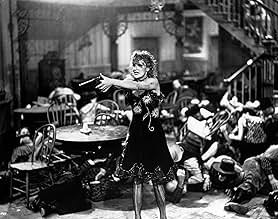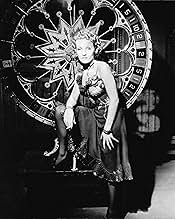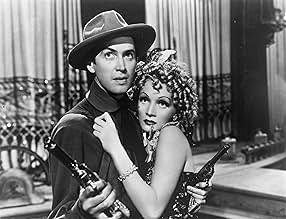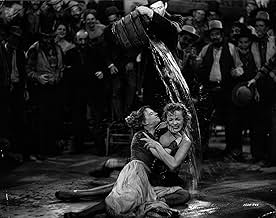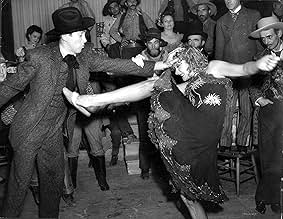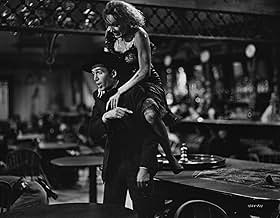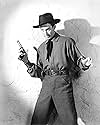CALIFICACIÓN DE IMDb
7.6/10
13 k
TU CALIFICACIÓN
Agrega una trama en tu idiomaDeputy sheriff Destry tames the town of Bottle Neck, including saloon singer Frenchy.Deputy sheriff Destry tames the town of Bottle Neck, including saloon singer Frenchy.Deputy sheriff Destry tames the town of Bottle Neck, including saloon singer Frenchy.
- Premios
- 1 premio ganado en total
Argumento
¿Sabías que…?
- TriviaAccording to her grandson Peter Riva, who was interviewed for the Icons Radio Hour, Marlene Dietrich's fight scene was unchoreographed. She and Una Merkel agreed to do it impromptu with the only rule being no closed fists. They used feet, pulled hair, and Marlene had bruises for weeks afterwards, but the director got everything in one take.
- ErroresTom Destry (James Stewart) makes the typical movie actor mistake of shooting his pistol at something by jerking the pistol and firing the gun at the target at the same time. In reality, if a shooter did that he would be moving the pistol off line and would miss every time, because the motion of the hand would impart a vector onto the bullet that would make it miss. Also, shooting that way is incredibly inaccurate. A real shooter would level the pistol at the target and then pull the trigger. Audie Murphy, a trained marksman, shot his pistols correctly in the remake Honor y venganza (1954).
- Citas
Tom Destry Jr.: Oh, I think I'll stick around. Y'know, I had a friend once used to collect postage stamps. He always said the one good thing about a postage stamp: it always sticks to one thing 'til it gets there, y'know? I'm sorta like that too.
- ConexionesFeatured in AFI Life Achievement Award: A Tribute to James Stewart (1980)
- Bandas sonorasSee What the Boys in the Back Room Will Have
(1939) (uncredited)
Lyrics by Frank Loesser
Music by Friedrich Hollaender
Sung by Marlene Dietrich
Opinión destacada
Destry Rides Again (1939)
A brilliantly made spoof of the early American Western. This came out at a strange time for this kind of reflective comedy, because in fact the Western was just this year having a revival with three serious Westerns including John Ford's legendary Stagecoach. But the fixtures of this kind of movie were well in place--the barroom brawl, the bad men and their guns, the good sheriff coming to the rescue, the sweet untainted woman and the quasi-whorehouse type woman, and of course the final shootout. It's all here. And it's a wild ride done with subtlety, a difficult combination to pull off.
It's fun to see this movie and then compare to the later generation of take-offs and spoofs that take themselves much more seriously--the spaghetti Westerns of the 1960s. These, too, used all the clichés of the Western to make an amusing reference to those types. The reason why those movies worked so well, and why Destry does, too, is that these are attractive archetypes. We see ourselves in these people, somehow, and yet not too closely. We identify with them (especially Jimmy Stewart the sheriff and Marlene Dietrich the bad woman with a good heart who can sing, too) and yet know they are all artifice, just as in a play. The illusion of reality is damped down by the excess and the fun, and the obvious exaggerations.
As for director George Marshall, he's a hardened Hollywood veteran most famous, perhaps, for a long string of golf movies (yes golf, the sport). But his expertise, and his willingness to go for broke with scenes involving dozens or even hundreds of people, and to use the camera vigorously, and to realize he had two of the greatest actors he could ask for (Stewart toward the beginning of his career, and Dietrich still a great star though cast against her normal romanticized type from the early 1930s) is phenomenal. You'll shake your head and laugh at the same time.
In fact, it is the chemistry of the two stars that gives the movie surprising depth. It's not just a farce. It talks about pacifism just as World War II is brewing. And it suggests something about true love as much as carnal attraction. All while the world is exploding around the two leads, almost literally, as you'll see. And whatever might happen on screen by the end, it's fun to know that the two had a real affair offscreen, with some hush hush scandal to follow years later.
Watch this and laugh and maybe even cry a little. Great stuff.
A brilliantly made spoof of the early American Western. This came out at a strange time for this kind of reflective comedy, because in fact the Western was just this year having a revival with three serious Westerns including John Ford's legendary Stagecoach. But the fixtures of this kind of movie were well in place--the barroom brawl, the bad men and their guns, the good sheriff coming to the rescue, the sweet untainted woman and the quasi-whorehouse type woman, and of course the final shootout. It's all here. And it's a wild ride done with subtlety, a difficult combination to pull off.
It's fun to see this movie and then compare to the later generation of take-offs and spoofs that take themselves much more seriously--the spaghetti Westerns of the 1960s. These, too, used all the clichés of the Western to make an amusing reference to those types. The reason why those movies worked so well, and why Destry does, too, is that these are attractive archetypes. We see ourselves in these people, somehow, and yet not too closely. We identify with them (especially Jimmy Stewart the sheriff and Marlene Dietrich the bad woman with a good heart who can sing, too) and yet know they are all artifice, just as in a play. The illusion of reality is damped down by the excess and the fun, and the obvious exaggerations.
As for director George Marshall, he's a hardened Hollywood veteran most famous, perhaps, for a long string of golf movies (yes golf, the sport). But his expertise, and his willingness to go for broke with scenes involving dozens or even hundreds of people, and to use the camera vigorously, and to realize he had two of the greatest actors he could ask for (Stewart toward the beginning of his career, and Dietrich still a great star though cast against her normal romanticized type from the early 1930s) is phenomenal. You'll shake your head and laugh at the same time.
In fact, it is the chemistry of the two stars that gives the movie surprising depth. It's not just a farce. It talks about pacifism just as World War II is brewing. And it suggests something about true love as much as carnal attraction. All while the world is exploding around the two leads, almost literally, as you'll see. And whatever might happen on screen by the end, it's fun to know that the two had a real affair offscreen, with some hush hush scandal to follow years later.
Watch this and laugh and maybe even cry a little. Great stuff.
- secondtake
- 12 jun 2010
- Enlace permanente
Selecciones populares
Inicia sesión para calificar y agrega a la lista de videos para obtener recomendaciones personalizadas
- How long is Destry Rides Again?Con tecnología de Alexa
Detalles
Taquilla
- Total en EE. UU. y Canadá
- USD 345,000
- Tiempo de ejecución1 hora 35 minutos
- Color
- Relación de aspecto
- 1.37 : 1
Contribuir a esta página
Sugiere una edición o agrega el contenido que falta

Principales brechas de datos
By what name was Mujer o demonio (1939) officially released in India in English?
Responda

